Table of Contents
Time allowed : 3 hours Maximum marks 100
GENERAL INSTRUCTIONS
- All questions in both the sections are compulsory.
- Marks for questions are indicated against each.
- Questions No. 1-5 and 17-21 are very short-answer questions carrying 1 nick each. They are required to be answered in one sentence each.
- Questions No. 6-10 and 22-26 are? short-answer questions carrying 3 marks each. Answers to them should normally not exceed 60 words each.
- Questions No. 11-13 and 27-29 are also short-answer questions carrying 4 marks each. Answers to them should normally not exceed 70 words each.
- Questions No. 14-16 and 30-32 are long-answers questions carrying 6 marks each. Answers to them should normally not exceed 100 words each.
- Answers should be brief and to the point and the above word limit should be adhered to as far as possible.
SET I
SECTION A
Question.1 How in any one way can an economy increase its production capacity?
Answer. Production capacity can be increased by improvement in production technology.
Question.2 Define indifference curve.
Answer. Indifference curve graphically represents many combinations of two commodities which yield equal satisfaction.
Question.3 What is the relation between price of a good and demand of its complementary good?
Answer. Inverse relation.
Question.4 What is marginal product?
Answer. Marginal product is the change in total product which takes place as a result of employing an additional unit of a variable input.
Question.5 Give two examples of implicit cost.
Answer.
- Rental value of the premises owned by the owner of the business organisation.
- Salary of the manager who is also the owner of the business.
Question.6 Define Production Possibility’Curve and state its properties.
Answer. Production Possibility Curve. In a simple economy various combinations of two commodities (say wheat and guns) can be produced with the full use of given resources. These combinations are called as production possibilities. When these combinations are graphically represented, the curve which is so formed, is called a production possibility curve.
Properties of Production Possibility Curve:
- Production Possibility curve is concave to the origin.
- It is downward sloping. PP curve may be defined as a curve which represents various possible combinations of two commodities that can be produced with full use of given resources in an economy under given technological conditions.
Question.7 What is Law of Diminishing Marginal Utility? Give a numerical example.
Answer. Law of diminishing Marginal utility states that as we consume more and more units of a commodity, the utility derived from each successive unit goes on decreasing. This law holds true under certain assumptions, i.e., a reasonable quantity of the commodity is consumed and that consumption is a continuous process. This law can be explained with the help of the following utility schedule.

The table shows that as the consumer consumes more units of ice cream, the marginal utility obtained from each successive unit goes on declining. Accordingly, MU curve slopes downwards from left to right.
Question.8 Price of a good rises by 25 per cent but there is no effect on demand of the good due to this price rise. Calculate price elasticity of demand.
Solution.

Question.9 State the phases in the behaviour of Total Product as per the Law of Variable Proportions. Use diagram.
Answer. According to Law of variable proportions. In the short run for increasing total product, units of variable inputs are increased. As a result of which total product passes through three phases (stages) as shown in the diagram
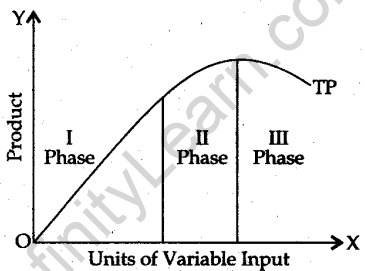
- In the first phase TP (Total Product) is increasing
at an increasing rate. - In the second phase TP (Total Product) is increasing at a decreasing rate.
- In the third phase TP (Total Product) declines.
All these phases have been shown in the diagram.
Or
State the relation between Marginal Product and Average Product. Use diagram.
Answer. Usually, the relation between Marginal Product and Average Product is as shown in the diagram. It passes through three phases:
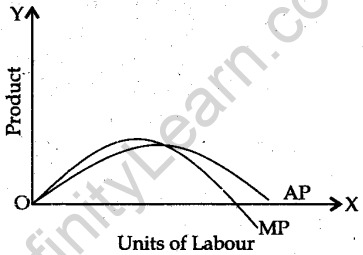
- In the first phase Total product increases at an increasing rate, when marginal product is increasing.
- In the second phase, Total product increases at a decreasing rate with the result average product is also decreasing but is more than Marginal product, when marginal product is positive but is less than Average product.
- In the third phase, Total product starts declining.
This happens when marginal product becomes
negative Average product also declines but is never negative. Total product is maximum when marginal product is zero.
Or
Note: The following question is for the Blind Candidates only in lieu of Q.No. 9.
State the phases in the behaviour of Total Product as per the Law of Variable Proportions.
Give a numerical example.
Answer. There are three phases in the behaviour of Total Product according to Law of Variable proportions. These phases can be easily comprehended looking at the schedule of Total Proudct given below :

Or
State the relation between Marginal Product and Average Product. Give a numerical example.
Answer. The usual relation between Marginal Product (MP) and Average Product (AP) is as following:
- In the beginning MP increases at increasing rate, hr this phase MP > AP.
- Later on, in the second phase, MP is positive but declines. In this phase MP < AP.
- In the last phase. MP becomes a negative item. MP < AP.
These phases can be understood looking at the schedule given below:

Question.10 Explain the geometric method of measuring price elasticity of supply. Use diagram.
Answer. According to the geometric method, elasticity of supply is measured at a point on the supply curve. To explain this method we draw three straight line supply curves. To measure elasticity of supply at a point, we extend the supply curves so that these meet X-axis at point B. In the first diagram point B is in the negative range, in the second diagram point B is in the positive range and in the third diagram point B is exactly at the point of origin. Elasticity of supply (say) at point A is equal to the horizontal segment BC divided by the quantity supplied at point A. Thus, Es = BC/OC.


Note : The following question is for the Blind Candidates only in lieu of Q. No. 10.
Explain the Law of Supply. Give a numerical example.
Answer. The law of supply states that there is a direct relationship between the price of a commodity and its supply. This means, when price is more supply is more and vice-versa. The other things which are assumed to be constant are—technology, input prices and tax pattern. If these things do hot hold good then the direct relationship between price of a commodity and its supply may not hold good.
![]()
Question.11 Market for an essential item of consumption is in equilibrium, but the equilibrium price is too high for the common man. What can the government do to bring down its market price but only through the normal market forces? Explain the chain of effects of the government’s action.
Answer. The essential items of consumption have to be made available to the people even when their prices are high. Now the question arises as to how to tackle the problem of price- rise so that the supply of these items is not reduced. In such a case the government should give subsidies to the manufacturing firms so that the inputs become cheaper or the cost of production comes down so as to reduce the price of such commodities.
Question.12 Explain how do the following influence supply of a good:
- Taxes on production.
- Changes in prices of other goods.
Answer.
- Taxes on production, Government imposes various types of taxes on production,
such as Excise duty, Slles tax, Customs duty etc. Imposition of a tax raises the cost of production. This in turn will have an adverse effect on production and may , discourage the producer from.producing these goods and the supply of these goods may decrease. - Changes in prices of other (related) goods. If price of a related good increases, supply of that commodity will increase and supply of initial commodity will decrease and vice-versa. For example, If the price of rice increases then a farmer will increase its production and therefore supply of wheat will decline.
Or
Explain how do the following influence supply of a good:
- Technological changes.
- Changes in prices of inputs
Answer.
- Technological changes. Advancement in technology is a continuous process on account of research activities which constantly take place in an economy. When there is an improvement in technology, cost of production per unit declines, with the result supply increases.
- Changes in prices of inputs. The increase in the price of factors of production leads
to an increase in the cost of production which adversely affects the supply of a commodity. .
For example, when factor prices go up, the cost of production goes up. With the
result, the supply of a commodity will be less at a given price. Hie reverse will be the case when factor prices decline.
Question.13 A consumer consumes only two goods X and Y and is in equilibrium. Show that if price of good X rises, it will lead to fall in demand for X.
Answer.

Question.14 Explain the meaning of ‘monotonic preferences’. Also explain why an indifference curve is (a) downward sloping and (b) convex to the origin.
Answer. See Q. 15, 2011 (III Delhi).
Or
Explain the CQncept of Marginal Rate of Substitution and its behaviour in the Indifference Curve analysis. Use a schedule.
Answer.
Marginal Rate of Substitution (MRS) may be defined as the amount of Y sacrificed for obtaining an additional unit of X. Say, for obtaining an additional unit of X, 4 units of Y are foregone,

Question.15 Giving reasons identify the equilibrium level of output and find profit at this output using ‘Marginal Cost and Marginal Revenue’ approach from the following:

Solution.

The equilibrium level of output is 3 units because at this level MC = MR. At this level profit is (TR – TC) Rs1. MC and MR are also equal at 1 unit level but the profit there is zero.
Question.16. Explain the implications of the following in an oligopoly market:
- Interdependence between firms,
- Barriers to the entry of new firms
Answer.
- Interdependence between firms. Under oligopoly there is interdependence among the firms. This signifies that the seller cannot change the price independently. Though the seller is free to pursue independent price policy, but in practice he does not change the price, because of the fear of retaliation by other sellers.
This is so because if he increases his price, Others may not increase and his sale will fall. On the other hand, if he lowers the price, Others may also lower their prices and he may not get the benefit of that. Therefore price tends to be rigid under oligopoly. - Barriers to the entry of new firms. New firms can enter the market but practically it is difficult for them due to requirement of huge capital or operating at minimum average cost or artificial barriers due to patent rights which prevent entry of new firms in the industry. Therefore for all practical purposes, new firms cannot enter the market.
SECTION B
Question.17 Define national income.
Answer. National income is the money value of final goods and services produced within the domestic territory of a country in a year plus net factor income earned from abroad.
Question. 18 What is macroeconomics?
Answer. Macroeconomics is the study of behaviour of aggregates of an economic system.
Question.19 Name any one step that the government can take through its budget to check inflation that is causing hardships to the people.
Answer. The Government should reduce public expenditure to check inflation.
Question.20 What are time deposits in banks?
Answer. Time deposits are the deposits which have been made for a prescribed period and earn interest. These can be withdrawn from the bank on demand.
Question.21 Define final goods.
Answer. Final goods are the goods which are used for consumption and investment arid once produced, lie outside the production boundary.
Question.22 Explain the ‘Store of Value’ function of money.
Answer. Store of value. It was virtually impossible to store surplus value under barter economy. The discovery of money has removed this difficulty. With the help of money, people can store surplus purchasing power and use it whenever they want. Saving in the form of money is not only secure but its possibility of being destroyed is very less. Besides, it can be used whenever need be. By facilitating accumulation of money, money has become the only basis of promoting capital formation.
Or
Explain the ‘Unit of Account’ function of money.
Answer. Money as a unit of account. Money measures the value of various goods and services : which are produced in an economy. In other words, money works as unit of value or unit of account/ In a barter economy it was very difficult to decide as to how much volume of goods should be given in exchange of a given quantity of a commodity. Money, by performing the function of common measure of value, has saved the society from this difficulty. Now the value of all goods and services are expressed in terms of money such as Rs 20 per metre, Rs 10 per kilogram etc. In this way, money works as a common measure
of value or account by expressing value of all goods and services in terms of money in the exchange market. By working as a unit of value, money has facilitated modem business and trade.
Question.23 Calculate equilibrium national income from the following:
(i) Consumption expenditure at zero income Rs 60
(ii) Marginal propensity to consume Rs 0.9
(iii)Investment Rs 100
Answer.

Question.24 Differentiate between aggregate demand and aggregate supply.
Answer.
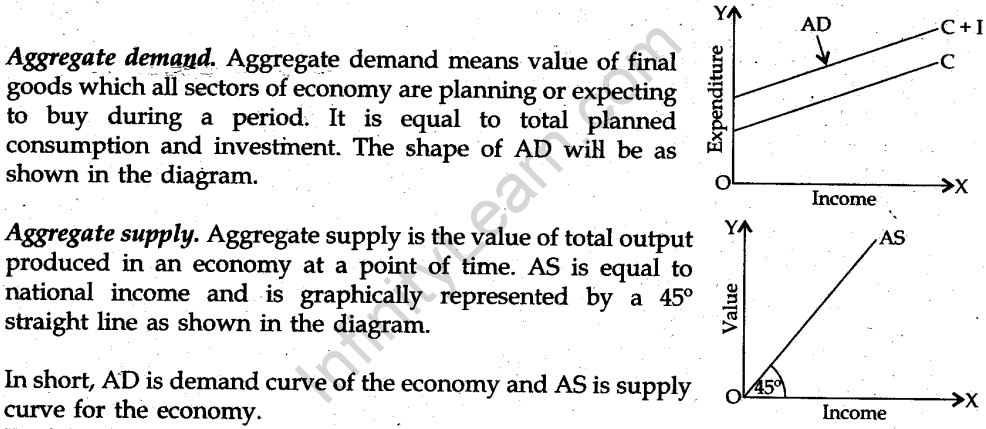
Question.25 Explain the basis of classifying government receipts into revenue receipts and capital receipts. Which type of these receipts are borrowings by government and why?
Answer. The basis of classifying receipts into revenue receipts and capital receipts is whether a receipt creates or reduces liability. A receipt which does not either create a liability or lead to reduction in liability is revenue receipt such as tax revenue. On the other hand, a receipt which either creates a liability or leads to reduction in liability is a capital receipt. Borrowing by the government is a capital receipt because borrowing creates a liability for the government.
Question.26 Foreign exchange rates have risen considerably in a country. What is its likely impact on imports of that country and why?
Answer. Foreign exchange rates have increased considerably in Country A. All the goods, which are imported will become more expensive. This simply means that for all its imports Country A shall have to pay more. Naturally, this will adversely affect Country A’s imports. In such a situation all efforts are made to reduce imports.
Question.27 What is Legal Reserve Ratio? Explain its components.
Answer. Legal reserve ratio is the sum of Cash Reserve Ratio (CRR) and Statutory Liquidity Ratio (SLR). CRR is that part of deposits which Commercial Banks have to keep as reserve with the Central Bank of the country. Statutory Liquidity Ratio is that part of deposits which the Commercial Banks have to keep with themselves in Cash and designated assets and securities.

Question.28 Reduction in income inequalities raises welfare of the people. How can government help through government budget, in this regard? Explain.
Answer. Income inequalities adversely affect welfare of the people. This is so because low income group people find it difficult to satisfy even their basic needs. Therefore, for increasing the level of welfare, income inequalities should be reduced. In this regard the government can take appropriate steps through the budget. In order to do that, Government taxes the rich and spends the money for such projects that benefit the poor people, such as providing free education, free health care, minimum wages etc. In India, Government spends a lot on such projects that benefit the poor.
Question.29 Explain the concept of ‘deficit’ in the balance of Payments.
Answer. See Q. 25, 2010 (I Delhi).
Or
Are the following entered
- on the credit side or the debit side and
- in the current account or capital account in the Balance of Payments account? You must give reason for your answer.
(a) Investments from abroad.
(b) Transfer of funds to relatives abroad.
Answer.
(a) Investments from abroad. Investment from abroad is entered on the credit side in the
Capital account because Investments from abroad bring in foreign exchange.
(b) Transfer of funds to relatives abroad. Transfer of funds to relatives abroad are entered on debit side of Current account because they involve outflow of domestic currency.
Question.30 Calculate (a) Private Income and .(b) Gross Domestic Product at Factor Cost.
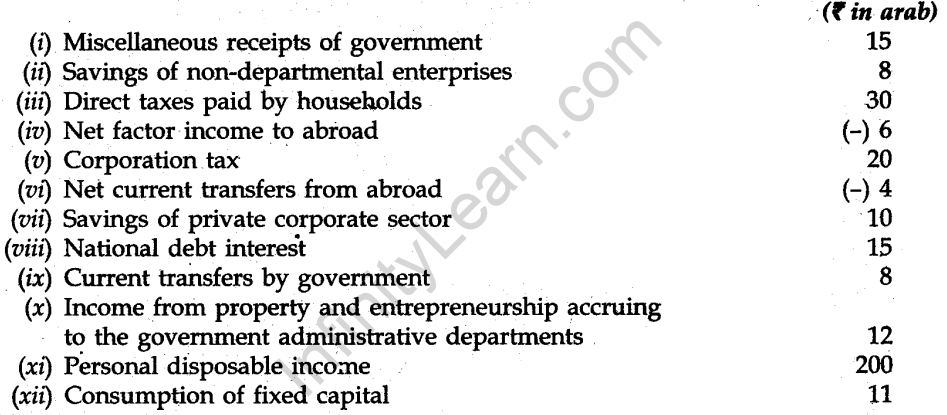
Solution.


Question.31 Explain the following:
- Why are imports deducted while calculating domestic product through the expenditure method?
- Why is ‘indirect tax’ deducted while estimating national income by expenditure method?
- Why are free facilities given to employees included in national income?
Answer.
- Net exports which is equal to (X – M) is a part of GDP according to the expenditure method. Imports are made from the rest of the world and they are not included in GDP.
- According to expenditure method national income is calculated at market price. Therefore, for finding out national income (NNP at Fc) indirect taxes are deducted.
- Free facilities given to employees are productive activities and form part of the salary/remuneration paid to the employees. Therefore these are included in national income, though these services are provided free of cost.
Or
Distinguish between ‘nominal income’ and ‘real income’. Explain why due to the presence of non-monetary production, real national income on its own cannot be treated as a true index of welfare.
Answer. Income measured at constant prices is real income. Changes in real income take place due to changes in the volume of goods and services and not in prices. Therefore, for the purposes of comparison, real income is used.
Income measured at current prices is nominal income. Changes in nominal income mainly take place on account of changes in the prices. Nominal income cannot be used for the purposes of comparison.
Many activities in an economy are not evaluated in monetary terms. For example, the domestic services women perform at home are not paid for. The exchanges which take place in the informal sector without the help of money are called barter exchanges. In a barter exchange, goods (or services) are directly exchanged against each other. But since money is not being used here, these exchanges are not registered as part of economic activity. In developing countries, where many remote regions are under-developed, these kinds of exchanges do take place. But they are generally not counted in the GDP of these countries. This is a case of under-estimation of GDP. Hence, GDP calculated in the standard manner may not give us a clear indication of the productive activity and well-being of a country.
Question.32 What is ‘excess demand’ in macroeconomics? Show the same in a diagram. Explain the role of ‘open market operations’ in reducing it.
Answer. When equilibrium level of income takes place in an economy before the stage of full employment, it is a situation of deficient demand. In this case, at the full employment level aggregate demand is less than aggregate supply.
When equilibrium level of income takes place after the stage of full employment, it is a
situation of excess demand. In this case, at the level of full employment aggregate demand is more than aggregate supply.
AD and AS are shown below in the diagrams.

Role of Open Market Operations. A number of methods can be used for comprehending the situation of excess demand. Open market operations is one of them. This means sale and purchase of government securities by the Central bank in the open market. Government securities are bought and sold by commercial banks to correct the situation of excess demand and deficient demand. For correcting the situation of excess demand, Central bank should reduce the supply of credit and for that it should sell securities in the open market which will be bought by the commercial banks. This leads to flow of money out of commercial banks and reduces the liquidity position of commercial banks and hence they give less credit. By this decline in the lending capacity of the banks, borrowings decline and their aggregate demand also declines.
Note: The following question is for the Blind Candidates only in lieu of Q.No. 32.
Distinguish between ‘excess demand’ and ‘deficient demand’. Explain the role of ‘open market operations’ in correcting excess demand.
Answer. Please read the above answer to Q. 32.
SET II
Note: Except for the following questions, all the remaining questions have been asked in Set I.
SECTION A
Question.1 What is meant by consumer’s equilibrium?
Answer. Consumer’s equilibrium means the quantity of a commodity which a consumer consumes to maximise his satisfaction, given his income and the price of the commodity.
Question.4 Define Average Product.
Answer.

Question.7 Price elasticity of demand of a good is (-) 4. When price of the good falls, its demand rises by 24 per cent. Calculate percentage change in price.
Solution.

Question.12 A consumer consumes only two goods X and Y and is in equilibrium. Price of good X falls. Show that it will lead to rise in demand for X.
Answer.

Question.14 Giving reasons identify the equilibrium level of output and find profit at this output using ‘Marginal Cost and Marginal Revenue’ approach from the following:

Solution.

SECTION B
Question.32 Calculate Personal Income and National Income:
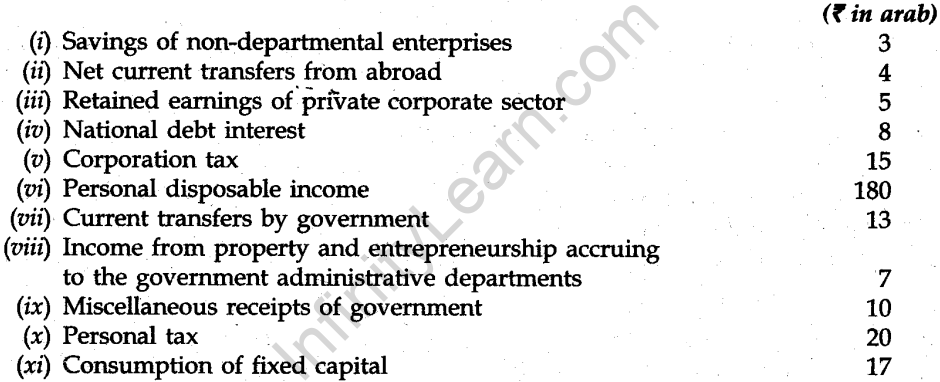
Solution.


SET III
Note: Except for the following questions, all the remaining questions have been asked in Set I and Set II.
SECTION A
Question.3 Define marginal revenue.
Answer. Marginal revenue is the change in toted revenue that takes place by selling an additional unit. In short,
![]()
Question.5 Define budget line.
Answer. The budget line is graphically shown as bundles of goods that can be bought by spending the entire income.
Question.6 Price elasticity of demand of a good is (-) 3. What is the percentage change in demand if the price of the product rises by 3 per cent. Calculate.
Solution.

Question.13 A consumer consumes only two goods X and Y and is in equilibrium. Show that if price of good Y falls, it will lead to rise in demand for, Y.
Answer.

Question.16 Giving reasons identify the equilibrium level of output and find profit at this output using ‘Marginal Cost’ and ‘Marginal Revenue’ approach from the following :

Solution.

SECTION B
Question.26, Calculate Marginal Propensity to Consume from the following:
- Consumption expenditure at zero income Rs 70
- Equilibrium income Rs 700
- Investment Rs 140
Solution. Here, Equilibrium Income, Y = Rs 700

Question.28 Explain the ‘Banker’s Bank’ function of the central bank.
Answer. Central bank is the bank of all the commercial banks in the country. This signifies that it has the same relationship with the commercial banks in the country which the commercial banks have with their customers. It keeps their required cash in reserve, provides them financial securities, gives them advice and discounts their bills and securities. It also
Question.31 Calculate Private Income and Gross National Product at Market Price:
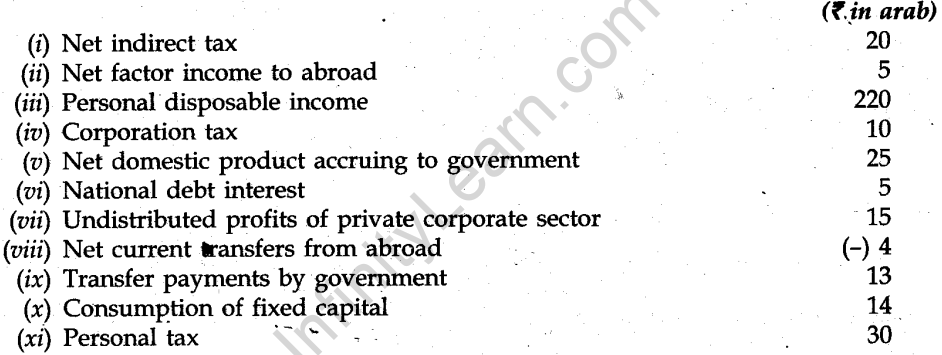
Solution.





